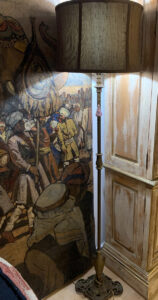 JE owns a beautiful wrought iron Spanish Colonial Revival Torchiere floor lamp hand wrought from the 1920s-30s. This lamp came on the market when electricity for lighting the home was a relatively new invention. First commercial application of the electric lightbulb happened in 1870, but not domestically. Because of the brightness of the light this invention was used for movie projectors, stage lighting, and to light dangerous streets.
JE owns a beautiful wrought iron Spanish Colonial Revival Torchiere floor lamp hand wrought from the 1920s-30s. This lamp came on the market when electricity for lighting the home was a relatively new invention. First commercial application of the electric lightbulb happened in 1870, but not domestically. Because of the brightness of the light this invention was used for movie projectors, stage lighting, and to light dangerous streets.
In 1802 Humprey Davy invented, by accident, the first electric light bulb, called the electric carbon arc lamp. He connected wires to an electric battery and a piece of carbon which to his surprise produced a glow. Finally in the 1910s affluent households began to use electric lightbulbs, and electricians created lamps for inside the home. Any fine vase became a candidate for electrification. I often find fabulous Ming dynasty vases of porcelain “drilled” for the insertion of an electrical cord. This makes interior lighting only a hundred years old. Widespread use of lightbulbs didn’t occur until after WWII in England and in the US.
Early Aesthetics of Lamps Tell Stories
All lamps needed a theme. They couldn’t simply hold a lightbulb. That’s why JE’s lamp looks like an architectural feature of an ancient Spanish gate. JE’s torchiere has a sugar barley twist surmounting a trefoil style circular base, and a dual pair of pull chair lights, true to 1920s Spanish Colonial Revival style.
The Spanish colonial flavor of the torchiere seems typical of the style of lighting when first introduced to American homes in the late 19th early 20th century. Designers meant for lamps to blend in with a themed interior decorating scheme. Instead of celebrating the newness of the technology of the electric lightbulb, lamp designs featured naked beauties holding lighted globes aloft, Arab merchants and their camels standing close to a blazing sun, leaded glass shades with dragonfly or lotus designs aglow. In this Revival era all “good” design referenced a previous era, such as the Gothic, Spanish Colonial, or Louis XV styles. Likewise JE’s torchiers references the grand oil-burning lights at the entries of Spanish Castles, created in curving wrought iron.
Santa Barbara owes much to the Spanish Colonial Revival style coveted in the first and second quarter of the 20th century in California. Many old 1920s Montecito mansions boasted wrought iron wall sconces of this “Spanish” design. The early 20th century saw the great period of Spanish Colonial Revival design, but California experienced a “soft” revival of that style in the 1970s and 80s.
Now to the designer of JE’s torchiere:
I attribute the style to New York metalwork designer Oscar B Bach. He designed in both the Gothic and Spanish Colonial. He base themed lamps by farming those two eras for 14th-17th century wrought iron architectural touches. A wealthy uncle noticed Bach’s artistic temperament in Berlin in the late 19th century. His family sent young Oscar to art school by the age of 8. At 14 he apprenticed to two important German masters of metal work. He studied in Vienna at the Royal Academy, and then at the Imperial Academy in Berlin. He opened a metalwork studio in Hamburg, then immigrated to New York. Bach gained a following from the wealthy upper class families in New York with “summer homes” in Montecito in the first half of the 20th century.
Bach became an influential artisan in first 20th century metal work in the Revival styles of past eras. However, the metalwork he did in antique revival styles celebrated modernity in significant ways. JE’s torchieres reference the style of 17th century Spain, but Bach understood electrical engineering so the lamp still functions well today.
Bach designed a metalwork telephone table in the 1920s rendered in the Spanish Colonial Style of curving wrought iron and marble, resembling a Spanish 17th century altar cubicles. Although the table and chair was meant for a telephone and not for a monastery. He skillfully incorporated one of the first private phones into the table that makes me think of a confessional. Bach was technically adept, stylistically diverse, and commercially successful. We see this from his clients in Montecito, and JE’s great-great aunt was one of these clients.
The value of JE’s torchiere is $700.